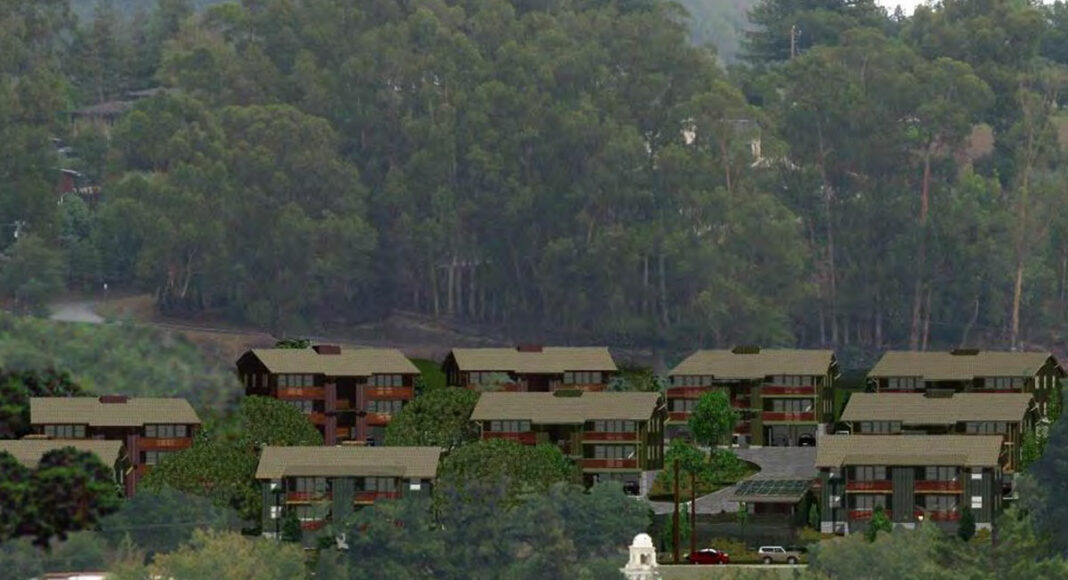Each side technically won something this month in the ongoing legal battle over a proposed housing project on Ocean Street Extension, but the court process may be far from over.
Santa Cruz Superior Court Judge Paul Burdick issued a split ruling Jan. 10 on the case. Burdick denied assertions by the Ocean Street Extension Neighborhood Association that the proposed development of 32 housing units violates the California Environmental Quality Act (CEQA). But he also directed the parties involved in the lawsuit—including the city of Santa Cruz—to revisit the wording of approvals or revisit the site plans related to development on slopes at the property.
The attorney for the neighborhood association is working on the wording of an order reflecting the judge’s ruling. The collaborative writing process includes input from the city, as well as from Craig Rowell and Rick Moe, who bought the land in April 2007 with a vision of building 40 housing units there. The resulting order will have to go back before the judge for approval.
The entanglement revolves around how the proposed development would dig into slopes in some areas of the 2.7-acre site at 1930 Ocean Street Extension. Plans for a development can allow for certain variations from city zoning code, and the plans for the Ocean Street Extension site allowed for some variations related to slope.
“There’s a number of provisions in the city code that protect slopes, and the city in our view ignored those provisions,” says attorney Bill Parkin, a partner at the Wittwer Parkin LLP firm, which is representing Ocean Street Extension neighbors in their case.
Even though the neighbors didn’t win on the CEQA issue in this round, the judge’s ruling on the slope aspect was a victory, Parkin tells Good Times. There is a “visual aspect” of developing on slopes, he says.
“There are obviously aesthetic impacts associated with doing that,” he says. “So it’s part and parcel of what you want your community to look like. Do you want the buildings to go up the slopes and up these hills and cover them, or you can say you’re not going to be able to build on that slope?”
The next court date is currently set for mid-April, though the parties could come back to the judge sooner with a proposal for how to address the slope debate. It’s unclear whether the next steps will require another City Council action, which depends on what the parties agree to and the judge’s final determination.
“We have no way of knowing when this is going to be resolved,” Rowell says.
Rowell says he and Moe consider themselves home builders, not developers. The latest twist in their attempt to build housing at the Ocean Street Extension property feels like a “needless complication,” Rowell says.
“The buildability of a building on any slope should be determined by a civil engineer or soils engineer, not by some arbitrary setback requirement,” he says. Since it is a sloping lot, any development there will require building into the slope “because it is a geographical reality of the property,” Rowell adds.
Santa Cruz councilmembers approved the proposed housing in a September 2018 City Council meeting, voting 5-2 to advance the project at 32 units instead of the proposed 40. The 20% reduction appeared to be an acknowledgement of neighborhood concerns. At least five of the units would be affordable.
The Ocean Street Extension Neighborhood Association then filed suit in October 2018 against Rowell and Moe, the city of Santa Cruz, and the City Council. The suit alleges—among other things—that the environmental impact report, a document required under CEQA for some projects, didn’t adequately analyze the cumulative impacts of the proposed development and failed to respond to many of the comments from neighbors in the report drafting process.
The judge found that the neighbors failed to establish those allegations, though.
Even if the remaining slope debate is resolved, the neighbors still have an opportunity to appeal the judge’s denial of the CEQA aspects of their case. No decision has been made yet on that, Parkin says.
All of it has Rowell wondering, “Is this what it takes to provide housing in Santa Cruz?”














More reporting please? Not only does the article not mention that the City violated its own ordinance in approving a permit on that property, but interesting that there is nothing at all about the fact that the particular slope in question holds up Graham Hill Rd, a major artery into town!
Major slides have occurred in that area, even in the last couple years. You should publish the photos of the huge mud slide on to Graham Hill Road right above this property which took out a white pickup and closed the road. Not to mention a slide down a nearby slope that nearly wiped out the townhomes at Jewell Court. Where was the engineer in those cases? Hardly a “needless complication” as stated by the developers…